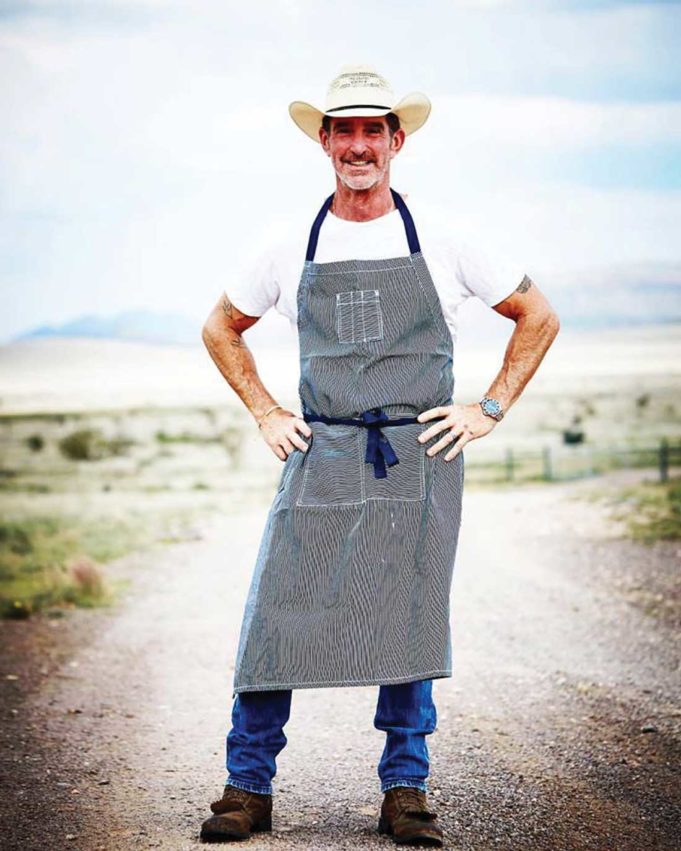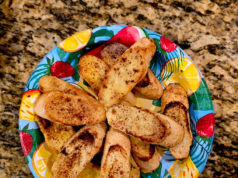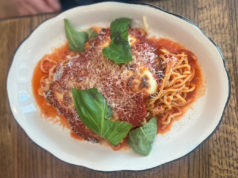With so many online and televised resources for home cooking available these days, you really don’t have a good excuse to serve b-grade dad grub anymore. Still, dudes in flip-flops and jorts are ruining perfectly good cuts of meat in backyards all over the world.
Local chef and restaurateur Lou Lambert has built his reputation by merging the worlds of fine dining and the colorful cuisine of West Texas. He is an undisputed master of the grill, and his fame has grown out of the kitchens of his restaurants, catering events, and his Hunt and Fish Social Club on the Near Southside, where he hosts occasional supper club dinners and special events.
Lambert shared some tips for home grillers, in the hopes that party guests everywhere won’t have to suffer the ills of bad grilling anymore. What a saint.
Fort Worth Weekly: What is the most common mistake home grillers make?
Chef Lou Lambert: Most home grillers don’t cook over a hot enough fire, and they [should] have two heat zones on their grill – high and low heat. In a restaurant, we start grilling over a very hot fire to sear and caramelize the meat and then, if it is a thicker cut, move it onto the low-heat side of the grill to finish cooking to the desired temperature.
A lot of home grillers shy away from fish. What can they do to make cooking fish easier and better?
Fish can be tricky, even for experienced grillers. Here are a couple of tricks. Make sure your grates are cleaned and well seasoned with oil. When seasoning the fish, start by rubbing both sides with a good olive oil and then add the seasoning. Cook the fish over a hot fire. This will ensure that the fish forms a crust when it hits the heat and doesn’t stick to the grates. When you place the fish on the hot fire, give it time to form a crust before trying to move or turn it. If it seems to be stuck to the grates, allow it to cook a little while longer, and most of the time it will release. [And] if you’re cooking fish with the skin on –– I love crispy charred fish skin –– score the skin with a sharp knife several times to keep the fish from cupping when it hits the heat.
Do you prefer charcoal or propane?
My first preference for a fuel source is hard wood burned to charcoal, then charcoal, and then propane. It’s all about imparting flavor while grilling. All of these fuel sources will provide heat, but live wood and charcoal provide flavor to the grilled item.
Explain the differences between grilling, barbecuing, and smoking.
Grilling is lighting a fire under some type of grates and cooking your meat over direct high-temperature heat, one side at a time – the best method to sear and caramelize a small tender cut of meat.
Barbecuing is cooking using indirect heat from wood or charcoal at a low temperature in an enclosed pit. This is best method for larger and tougher pieces of meat that need long cooking times in which you add moisture.
Smoking is also cooking using indirect heat using live wood or charcoal. There are basically two types of smoking: 1.) cold smoking, done over very low heat – usually 90 degrees or lower – where you are just trying to impart flavor and/or dry the product you’re smoking; and 2.) hot smoking – usually 120 degrees or higher; proteins coagulate at 120 or higher – in which you are trying to impart flavor and cook the meat.
Is there a particular combination of chips, wood, that you prefer when smoking or grilling?
Whether smoking, wood roasting, barbecuing, or grilling, I prefer hard wood. For grilling, we burn down wood to charcoal. When we are roasting large pieces of meat over charcoal, we will use fire barrels to burn wood to charcoal and then shovel the coals into the roasting pit.
Is there one piece of equipment that every would-be grill master should own and use frequently?
Invest in a large, well-built grill with cast iron grates. Cast iron grates are the only thing I will grill over. They get hot and hold the heat, ensuring you get great grill marks and the meat won’t stick to the grates.
I would also get a rotisserie attachment for your grill. I love slow-roasting chickens, prime ribs of beef, and baskets of vegetables and potatoes over a fire. It’s a great alternative to grilled steaks.
What is the most underrated cut/protein for grilling?
A thick center-cut pork loin chop. This is a fairly reasonably priced cut of meat, and you can really add a lot of flavor and moisture with brining and a good dry rub.
Where do you get your inspiration for your unique barbecue recipes?
Most of my inspiration comes from memories growing up in West Texas watching my father grill steaks and going to big barbecues where they would slow roast cabrito and large primal cuts of beef. It was about the technique, fire, rubs, wet mops, and carving. Everyone had their own little secret of how they did it and philosophy of what made a good barbecue.
Will you share on of your favorite grilling recipes with our readers?
This has been our best-selling pork dish at the restaurant for years. The brine is a great way to add flavor and moisture to pork. The combination of the citrus brine with the sweetness of the brown sugar dry rub – which develops a crust when grilled over an open fire – gives these pork chops a unique, full flavor.
Grilled Porterhouse Pork Chops
6 servings
- 6 brined porterhouse pork chops, 12 oz each (brine recipe below)
- ½ cup of brown sugar pork rub (recipe below)
Start a hot fire in your grill. Bring the brined pork chops out of the refrigerator and brush off any herbs and spices from the brine, pat dry. Lightly coat each side with the brown sugar pork rub. Grill the pork chops on each side for about 5 minutes over a medium-hot fire until the internal temperature reaches 165 degrees. Because the chops have a brown sugar rub, watch that your fire does not flare up or that the coals are not too close to the grill grates. Remove the cooked pork chops to a plate and allow them to rest for at least five minutes. Serve the pork chops with fruited herb-grain mustard and apple-walnut slaw.
Citrus Brine
- 4 cups water, divided
- ½ cup kosher salt
- 1 bay leaf
- 1 tsp coriander, toasted
- 1 tsp fennel seed, toasted
- 1 tsp whole black pepper corns
- ¼ cup brown sugar
- ½ cup onion, roughly chopped
- 2 cloves garlic, crushed
- 1 orange, quartered
- 2 sprigs of fresh thyme
Bring 1 cup of water to a simmer and add the salt, bay leaf, coriander, fennel seed, black pepper, sugar, onion, and garlic. Whisk and simmer for about 1 minute until salt has dissolved. Add the water and spice mixture to the remaining water. Juice the orange into the brine mixture and add the orange segments and fresh thyme. Let the brine cool in the refrigerator.
To brine chops: Place pork chops in a plastic tub or large sealable plastic bag and pour brine over the chops. Place the container in the refrigerator and allow the chops to brine for 8 to 12 hours. Remove the chops from the brine and scrape off any of the spices and pat dry. Hold in the refrigerator until you are ready to grill.
Brown Sugar Pork Dry Rub
- ½ cup water
- ¼ cup brown sugar
- 2 tsp kosher salt
- 1 tsp medium ground black pepper
- 1 tsp paprika
- 1 tsp chile powder
- 1 tsp coriander, toasted and ground
- 1 tsp fennel seed, toasted and ground
Mix together all of the spices and store in an airtight container.
Fruited Herb-Grain Mustard
Makes 2 cups
- ¾ cup grain mustard
- ½ cup Dijon mustard
- ¾ cup fruit chutney
- 1 tsp fresh chives, finely chopped
- 1 tsp flat leaf parsley, finely chopped
- ¼ tsp kosher salt
- ½ tsp black pepper, fine grind
Combine all ingredients in a small mixing bowl. Store in the refrigerator in an airtight container.












